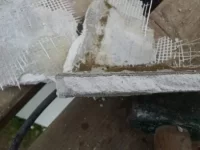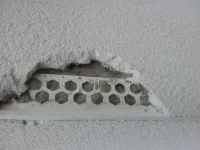toddylaguna
New Member
Hi All,
A tale of woe.
About 2 years ago we had a new extention, built of lightweight blocks, rendered in a CPI two coat system with a mesh set into the basecoat. About six months later we noticed that one corner of the render had blown. We contacted CPI and the rendering company who both said it was an underlying problem with the structure. The renderer offered to repair the blown area at extra cost to us. We buried our heads for a while. Slowly different areas have cracked and blown. CPI sent us an 'independent' materials specialist to look at what was going on. His report concluded that it was the structure and that the render was not the problem or the application. More time passed and we then contacted our structural engineer, As there was no cracking to the interior walls, which are hardwalled and then skimmed, he concluded the structure was fine. We then knocked off some off the top coat where it had blown and the base coat is just mush. Obviously water has got in where it has cracked, but surely the basecoat should remain solid and bonded. The renderer had said when he first came to look at the damaged area that we shouldn't worry as the basecoat was water proof, but in this case that can't be true. So any ideas why the basecoat would turn to mush? The topcoat although cracked and blown is still solid.
thanks T
A tale of woe.
About 2 years ago we had a new extention, built of lightweight blocks, rendered in a CPI two coat system with a mesh set into the basecoat. About six months later we noticed that one corner of the render had blown. We contacted CPI and the rendering company who both said it was an underlying problem with the structure. The renderer offered to repair the blown area at extra cost to us. We buried our heads for a while. Slowly different areas have cracked and blown. CPI sent us an 'independent' materials specialist to look at what was going on. His report concluded that it was the structure and that the render was not the problem or the application. More time passed and we then contacted our structural engineer, As there was no cracking to the interior walls, which are hardwalled and then skimmed, he concluded the structure was fine. We then knocked off some off the top coat where it had blown and the base coat is just mush. Obviously water has got in where it has cracked, but surely the basecoat should remain solid and bonded. The renderer had said when he first came to look at the damaged area that we shouldn't worry as the basecoat was water proof, but in this case that can't be true. So any ideas why the basecoat would turn to mush? The topcoat although cracked and blown is still solid.
thanks T




